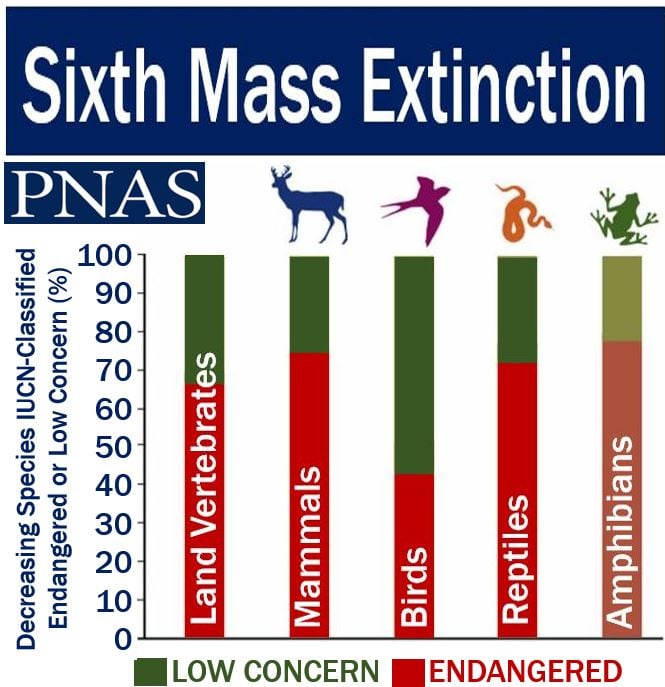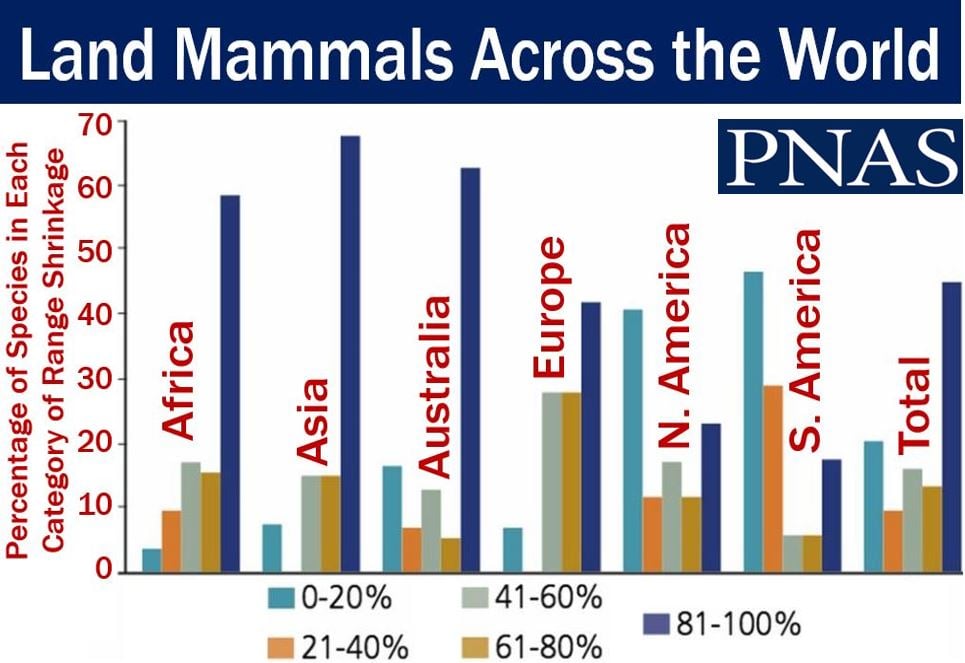The sixth mass extinction is currently underway, say scientists from the Universidad Nacional Autónoma de México (UNAM) and Stanford University. A biological annihilation of fauna over the past few decades means that we are in the middle of our planet’s sixth mass extinction, say Paul R. Ehlich and Rodolfo Dirzo, both from Stanford, and Gerardo Ceballos from UNAM.
In a study published in Proceedings of the National Academy of sciences (PNAS) on July 10th, titled – “Biological annihilation via the ongoing sixth mass extinction signaled by vertebrate population losses and declines” – the authors blamed human overconsumption and overpopulation for the current crisis, and warn that it threatens not only the survival of innumerable species, but also our own civilization.
There is still time for us to act, the researchers explain, but the window of time is extremely short.
What is a mass extinction?
As the name suggests, a mass extinction is the extinction of a huge number of species over a relatively short space of geological time. Scientists say that they are due to a catastrophic global event, such as a giant asteroid impact, or any widespread environmental change that happens too quickly for most species to adapt.
 The % of decreasing species classified by IUCN as ‘endangered’ or ‘low concern’ in terrestrial vertebrates. This image emphasizes that even species that have not been classified as endangered yet (approx. 30% of vertebrates) are declining. In the case of birds the situation is exacerbated, with nearly 55% of decreasing species still classified as ‘low concern’. (Image: adapted from pnas.org)
The % of decreasing species classified by IUCN as ‘endangered’ or ‘low concern’ in terrestrial vertebrates. This image emphasizes that even species that have not been classified as endangered yet (approx. 30% of vertebrates) are declining. In the case of birds the situation is exacerbated, with nearly 55% of decreasing species still classified as ‘low concern’. (Image: adapted from pnas.org)
In Earth’s history, there have been five mass extinctions that we know of, according to fossil records. They occured at or toward the end of the Cretaceous, Triassic, Permian, Devonian and Ordoician Periods.
The largest mass extinction occured 245 million years ago during the Permian Period (the Permian Extinction). Scientists believe that approximately 90% of all marine species vanished. A team of scientists from the UK, Germany and Austria believes that ocean acidification caused that mass extinction.
Seventy-five percent of species became extinct 65 million years ago, during the Cretaceous Period (the Cretaceous Extinction). A large asteroid crashed next to what is today Mexico’s Yucatan Peninsula. During this period the dinosaurs became extinct.
Current Sixth Mass Extinction will surprise many
Most of us are aware of species extinctions, and are frequently warned that we need to make greater effort to protect non-human life on Earth.
However, there is a common misimpression that our planet’s biota (animal and plant life) is not immediately threatened, but is simply gradually entering an episode of major biodiversity loss.
 This image shows the percentage of land mammal species from five major continents/subcontinents and the world total undergoing different degrees of decline in the period c.1900 to c.2015. Fifty-six percent of the species sampled globally have lost over 60% of their range. This pattern is generally consistent in Europe, Asia and Africa, while in North and South America 35% to 40% of species have experienced range contractions of up to 20%. (Image: adapted from pnas.org)
This image shows the percentage of land mammal species from five major continents/subcontinents and the world total undergoing different degrees of decline in the period c.1900 to c.2015. Fifty-six percent of the species sampled globally have lost over 60% of their range. This pattern is generally consistent in Europe, Asia and Africa, while in North and South America 35% to 40% of species have experienced range contractions of up to 20%. (Image: adapted from pnas.org)
This view, the authors warn, overlooks the current trends of declines in the populations of an alarmingly-high number of species as well as extinctions.
Using a sample of 27,600 terrestrial vertebrate species, and a much more detailed analysis of 177 mammal species, the scientists claim that their study shows the extremely high degree of population decay in vertebrates, even in species which we currently rate as of ‘low concern’.
Shrinking populations in a wide range of species “amount to a massive **anthropogenic erosion of biodiversity and of the ecosystem services essential to civilization,” the authors warn, “This biological annihilation underlines the seriousness for humanity of Earth’s ongoing sixth mass extinction event.”
**Anthropogenic means caused by human activity.
Alarming population and habitat loss
Of the 177 mammals for which the scientists have detailed data, every single species has lost at least 30% of its geographic range, while over 40% of the species have experienced population declines of at least eighty percent.
In an Abstract preceding the main article in the journal, the authors wrote:
“Our data indicate that beyond global species extinctions Earth is experiencing a huge episode of population declines and extirpations (exterminations), which will have negative cascading consequences on ecosystem functioning and services vital to sustaining civilization.”
“We describe this as a ‘biological annihilation’ to highlight the current magnitude of Earth’s ongoing sixth major extinction event.”
Video – Sixth Mass Extinction is here
In this Stanford University video, which came out two years ago, co-author Professor Paul Ehrlich explains that there is no longer any doubt – we are entering a mass extinction that threatens our very own existence.
